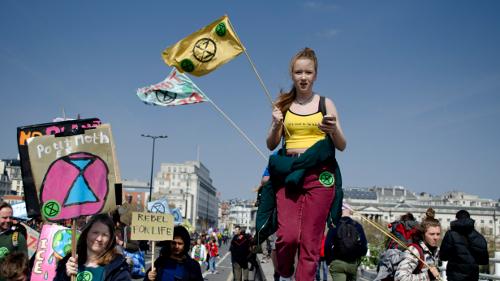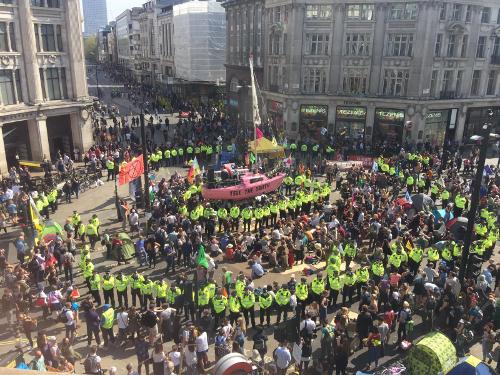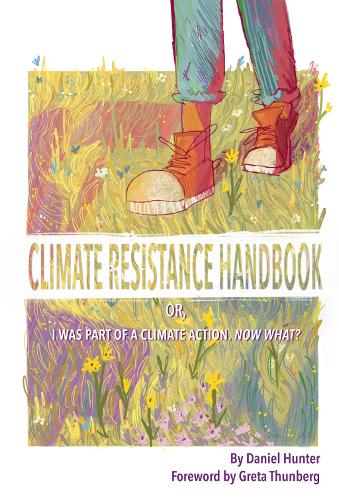

Over the past nine months, Extinction Rebellion (XR) has played a significant role in helping to push climate change way up the UK’s political agenda. For its boldness of vision, its commitment to nonviolence, its desire (and ability) to get large numbers of new people involved, its chutzpah and creativity, and for the sheer hard work that many of its activists have put into the cause, it deserves much praise.
XR co-founder Roger Hallam has noted that: ‘if we are serious about the truth we face we have to be serious about organising and rebelling effectively’. [1] Yet, notwithstanding its recent success, the XR leadership’s ‘apocalyptic organising’ and faulty strategy are likely to lead it into a dead end.
“XR’s ‘apocalyptic organising’ and faulty strategy are likely to lead it into a dead end”
Fortunately, a clear alternative – rooted in the practice of past successful movements and compatible with XR’s ‘self-organising system’ – already exists: building strong and sustainable movements, made up of numerous, tightly-focused, escalating direct action campaigns, to win ever-more-ambitious goals and demands.
In the XR video, ‘Why International Rebellion?’, Roger Hallam claims that there are only three options for those who want to tackle climate change: ‘more cheques to NGOs’, ‘violence’ and ‘mass participation civil disobedience’ – that is: ‘loads of people going to the capital city and… clos[ing] down that capital city until something dramatic happens’ [2] (see ‘XR: The Plan’).
Hallam rejects the first two possibilities and claims that the third is ‘our best bet’ – ‘there's not, like, a fourth option out there’.[3]
He’s wrong.
In fact, many of the most famous and successful examples of activism, such as the US civil rights movement, took just such a ‘fourth option’: building strong movements out of focused campaigns.

Focus and build
Longtime activist George Lakey defines a campaign as ‘a focused mobilization of energy with a clear objective, over a time period that can realistically be sustained by those who identify with the cause’, and a movement as ‘a cluster of campaigns related to a theme’. [4] For the rest of this article I will use these words with these specific meanings.
Examples of campaigns include the Earth Quaker Action Team’s success in forcing the PNC bank to stop funding mountain-top removal coal-mining. They used a wide variety of tactics including disrupting local branches and the closing of bank accounts. [5] Another is the UK poll tax rebellion of 1989–1990, which saw an estimated 18 million people refuse to pay the much-hated local flat tax. [6]
Examples of movements include the US civil rights movement of the 1950s and 1960s [7], the anti-nuclear power movement of the 1970s and 1980s [8] and the current global movement to get universities, churches and pension funds to divest from fossil fuels. [9] Campaigns – such as the iconic lunch-counter sit-ins and freedom rides – have been at the heart of all these movements.
Typically, Lakey explains, a campaign ‘makes a demand for one or more specific changes, identifies an opponent or “target” that can respond [usually a person or small group of people], and generates a series of nonviolent tactics that escalate over time.’ [10] ‘Successful campaigns focus on their target over time – nine months, two years, even more if they have the people resources – with a specific demand that seems achievable,’ he adds.
An ‘achievable’ goal isn't necessarily ‘easy’. What is achievable is clearly something that can shift over time – and which activists should be trying to shift, in part by waging campaigns! However, XR itself is not a campaign because its second demand – and, in its Hallam version, its third demand as well – currently fails the ‘achievability’ test (see ‘The Plan’).
One clear fourth option, with numerous historical precedents, is to seek to grow movements (made up of numerous different campaigns) to tackle the many different facets of our intertwined ecological, political and social justice crises.
We could then attempt to unify these (and other) movements around a common vision in order to create a ‘movement of movements’ capable of winning the major structural changes that we need.
The fact that this approach is rooted in campaigns (which can be local, regional, national or even international) has many advantages.
Done properly, campaigns are built for both sustainability and escalation, allowing activists to take the offensive and build their own timelines for change, using many different kinds of actions and tactics, giving full weight to the diversity of participants and priorities while at the same time connecting new allies and building grassroots leadership. [11]
As Lakey notes, ‘[r]unning a campaign is like taking a magnifying glass and holding it between the sun and a piece of paper. By focusing the energy of the sun, the glass ignites the paper.’ [12]
Such an approach doesn’t mean giving up on longer-term visionary goals. But it does recognise that these cannot be achieved overnight and that we need to build the people power, the skills and the vision to make the changes we want – and it provides a tried-and-tested method for building these very things.
In its videos, talks and literature, XR has repeatedly referenced the US civil rights era and its achievements. [13] But it has failed to acknowledge – or even recognise – that the victories of this era were rooted in scores of campaigns that moved, in less than a decade, from forcing the city of Montgomery to allow black passengers to sit where they liked in public buses (December 1956) to forcing the US government to pass the Civil Rights Act (1964) and the Voting Rights Act (1965).
These victories were not won by demanding a civil rights act at the outset and then repeatedly mobilising people to block traffic in Washington DC until the US government gave in to this demand – XR’s ‘mass participation civil disobedience’ model (see ‘XR: The Plan’).
What to do?
So what would this fourth option look like here in the UK?
Well, several movements and campaigns connected to climate change already exist, including: the divestment and anti-fracking movements, the campaigns to end Big Oil’s sponsorship of our cultural institutions (thereby undermining their ‘social licence to operate’), and the campaign to stop a third runway at Heathrow. But many, many more will need to be created, and XR groups and others should be focusing a substantial portion of their energies on helping to create and win these.
For example, the global climate action group 350.org is currently gearing up to launch a major direct action movement around the ultimate goals of: (a) an immediate ban on new permits for new fossil fuel projects or the expansion of existing projects (including exploration, extraction, transportation and power); and (b) the immediate introduction of regulation to stop public and private financial flows to and from fossil fuel companies and projects. [14]
XR’s first demand (‘Tell the truth’) has helped spur the pre-existing push to get local authorities to pass ‘climate emergency’ motions. This now needs to pass onto the second – and much more difficult stage – of creating a movement of campaigns to force local authorities into making these aspirations a reality.
A recent report by Friends of the Earth lists 33 individual actions that local authorities could be taking on climate change as well as three over-arching ‘strategic actions’ that all such authorities need to be taking: (1) making a political commitment to reduce greenhouse gas emissions; (2) developing a carbon reduction pathway; and (3) raising funds for action. [15]
All of these actions could be focus points for local and regional campaigns and movements. And major national campaigns will be needed, both to create a statutory duty for local authorities to develop and implement carbon reduction pathways, and to ensure that they have the additional funding necessary to do this.
Cross-class alliances should be built around campaigns at the local, regional and national level to win victories on home insulation. This is universally recognised as an essential part of decarbonising the British economy. It is also a win-win for the general public (lower bills and warmer homes) that could then serve as a stepping-stone to more contentious changes.
According to the Committee on Climate Change, home insulation rates in the UK have dropped by 95 percent since 2012, following the removal of government incentives. [16]
Campaigns will probably also have to be fought to roll back the veto powers recently granted to local communities to block onshore wind (one of the cheapest forms of renewable power) and to neutralise the powerful anti-fuel tax lobby.
Campaigns will need to be fought to amend the Climate Change Act: not just to tighten its end goal to ‘zero carbon’ but to drag forward its deadline from 2050 and to eliminate its current loopholes.
Campaigns will also need to be fought in solidarity with people in frontline communities in the global south, to ensure that the transition to a global zero-carbon economy is a just one.
Major rewilding and basic income schemes – both of which have been suggested as major parts of the solution to our current crisis [17] – will need campaigns and movements behind them if they’re ever going to become reality.
And that’s not even the half of it.
An acceleration
Let us be clear: none of this is ‘business as usual’.
To carry out anything on this scale will require both an acceleration of forward steps and the sort of urgency of commitment that XR and the climate strikers are already demonstrating.
But ask yourself which seems more likely. That thousands of people blocking traffic in central London over the next few years will force the government to hand over power to an unelected citizens’ assembly, which will then decide to make rapid and unprecedented economic, social and political changes across UK society and that these will then be implemented?
Or that hundreds of inter-connecting and reinforcing campaigns, from local to national, build the power needed to make these and other changes over the coming decade?
Some local XR groups appear to be naturally gravitating towards setting up campaigns.
For example, Brighton XR has apparently decided to work alongside local students who’ve been striking for action on climate change, as well as other local groups, to target Brighton University with demands for it to move its money out of Barclays (as part of People and Planet’s campaign to get the bank to stop financing fossil fuels) and to get the university to back the divestment of the East Sussex Pension Fund (to which it is a significant contributor).
XR’s ‘self-organising system’ certainly allows for such developments. Indeed, according to XR’s own manuals ‘[a]ny person or group can organise autonomously around the issues that feel most pressing for them, and take action in the name and spirit of [XR] – so long as the action fits within [its] principles and values.’ [18]
However, for the ‘campaigns and movements’ option outlined above it is important: (1) that groups actually dig in to win their demands from their targets (as opposed to scattershot one-off protests that may generate some media interest but are unlikely to achieve much in the way of concrete victories); and (2) that groups resist thinking that the ‘rebellions’ (the big mass protests in London) are the main event and that the local and regional stuff are ultimately just recruitment tools for these.
For, as Lakey notes, it is ‘[w]hen growing campaigns build the direct action skills and attitudes for mass struggle, and merge into movements, and push those movements to join in a movement of movements, [that] we’ll have the people power to push aside the 1% and transform our countries.’ [19]
ENDNOTES
[1] Roger Hallam, Common Sense for the 21st Century: Only nonviolent rebellion can now stop climate breakdown and social collapse, 15 April 2019, https://www.rogerhallam.com/wp-content/uploads/2019/04/Common-Sense-For-The-21st-Century-Roger-Hallam.pdf (hereafter Common Sense), p. 51
[2] Extinction Rebellion, ‘Why International Rebellion?’, 5 April 2019, https://www.youtube.com/watch?v=8c2f_JmzoWU
[3] Ibid.
[4] George Lakey, Strategizing For A Living Revolution (hereafter Strategizing), https://www.historyisaweapon.com/defcon1/lakeylivrev.html
[6] https://nvdatabase.swarthmore.edu/content/british-rebel-against-poll-tax-1987-1990
[7] https://nvdatabase.swarthmore.edu/browse_waves/results/taxonomy%3A9941
[8] https://nvdatabase.swarthmore.edu/browse_waves/results/taxonomy%3A17448
[9] https://nvdatabase.swarthmore.edu/browse_waves/results/taxonomy%3A20321
[10] George Lakey, How We Win: A Guide to Nonviolent Direct Action Campaigning, Melville House, 2018, p.3.
[11] Daniel Hunter, Building a Movement to End the New Jim Crow, The Veterans of Hope Project, 2015, pp. 44 - 45
[12] Strategizing
[13] See for example, Extinction Rebellion, ‘Heading for extinction and what to do about it’, 18 September 2018, https://www.youtube.com/watch?v=b2VkC4SnwY0 (hereafter ‘Heading’), 41:20 – 42:06. Roger Hallam maintains that XR is ‘humbly following in the tradition of Gandhi and Martin Luther King … simply rediscovering what people do when they have had enough of failure and really want to make a difference’ (Roger Hallam, ‘Now we know: conventional campaigning won’t prevent our extinction’, Guardian, 1 May 2019, https://www.theguardian.com/commentisfree/2019/may/01/extinction-rebellion-non-violent-civil-disobedience). In fact, Hallam’s ‘main process’ for the rebellion (see 'XR: The Plan') bears little or no resemblance to the practice of either of these figures. Thus, Gene Sharp notes that in advance of his famous ‘salt march’ of 1930 ‘Gandhi sought to identify specific issues symbolising British oppression against which Indian noncooperation and civil disobedience could be focussed …. seek[ing] to make “independence” concrete by identifying eleven specific demands, including abolition of the salt tax and release of political prisoners’ (Gene Sharp, Waging Nonviolent Struggle: 20th Century Practice and 21st Century Potential, Extending Horizons Books, 2005, p. 103, emphasis added). He didn’t simply demand independence and then mobilise thousands to cause disruption in the capital. The same holds for the civil rights movement (see main text).
[14] https://350.org/disrupt-fossil-finance-action-training-to-resist-fossil-fuels/
[15] Friends of the Earth, ‘33 actions local authorities can take to deliver carbon pollution reductions’, March 2019, https://policy.friendsoftheearth.uk/sites/files/policy/documents/2019-03/33_actions_local_authorities_can_take_on_climate_change_final_draft.pdf
[16] Committee on Climate Change, ‘Reducing UK emissions – 2018 Progress Report to Parliament’ (hereafter CCC), 28 June 2018, https://www.theccc.org.uk/wp-content/uploads/2018/06/CCC-2018-Progress-Report-to-Parliament.pdf, p.12
[17] M.A. Maslin, ‘Climate change: essential knowledge for developing holistic solutions to our climate crisis’, Emerging Topics in Life Sciences, 24 April 2019, https://doi.org/10.1042/ETLS20180116
[18] Extinction Rebellion, ‘How to start a Local Group’, undated, https://rebellion.earth/wp-content/uploads/2019/04/How-to-start-a-local-Extinction-Rebellion-group.pdf, p. 5.
[19] George Lakey, ‘Why protests are usually a waster of time’, Peace News, December 2018, http://peacenews.info/node/9240/why-protests-are-usually-waste-time


